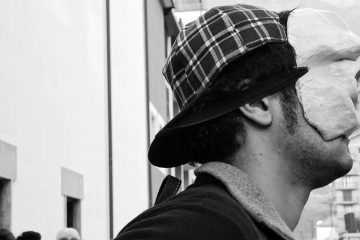

Over the last fifteen years, many documentaries have zoomed in on the tragic odysseys experienced by migrants and refugees hoping to reach the West in search of a better life.
Differently from these films, Yosr Gasmi and Mauro Mazzocchi’s latest effort, Geology of Separation, focuses on some everyday aspects of their suffering.
The feature was world-premiered in the Tiger competition of the International Film Festival Rotterdam earlier this year (25 January-5 February) and later took part in other specialised gatherings such as Burkina Faso’s FESPACO (25 February-4 March), Italy’s Biografilm Festival (9-19 June) and France’s FidMarseille (4-9 July).
"All in all, Geology of Separation is a commendable work because it takes a brave, unusual path to explore the migrants’ Waiting for Godot-like limbo"
The movie opens with a static, five-minute shot during which we can hear some voices and see the legs of several people walking around.
We realise that this is a reception centre wherein Italian medical staff and social workers interact with foreign migrants and refugees and that some of the subjects are afraid of being framed.
This first shot is later followed by the images of a CCTV filming a canteen while some people are having their lunch, with no sound recorded.
It’s quite an unwelcoming start for the viewers, which already sets a big distance between them and the subjects depicted. The black-and-white cinematography, used throughout the picture, also enhances this feeling of detachment.
Nevertheless, what we will see afterwards offers good food for thought. The film is divided into several chapters, indicated by intertitles displayed in Arabic.
In detail, the two helmers take a closer look at the vicissitudes of 23-year-old Abderhaman, a migrant who fled violence in Libya and is awaiting permission to remain in Italy, and 42-year-old Laly, who had received two negative responses to his asylum seeker applications and has been stuck in the centre for two years already. Despite the latter’s efforts to find a job and his will to learn Italian, it seems there’s no way out for the man.
We can notice that whenever Gasmi and Mazzocchi decide to give voice to the two protagonists by getting closer to them and letting events simply happen in front of the camera, Geology of Separation becomes a much more powerful piece of filmmaking.
In one of the first scenes, for example, Abderhaman is forced to take an interview to prove he went through enough hardship to be eligible for refugee status. He is asked to delve into details, while the interviewer adopts a lecturing tone, all the time.
It is a dehumanising moment, during which a man who has already suffered enough needs to prove that his pain is authentic in order to receive adequate assistance. In its simplicity, the scene is an effective portrait of the concrete consequences of the Eurocentric gaze.
In another scene, some of the reception centre’s workers complain about the dirt left behind by the migrants and refugees. We can sense the tension, and get a taste of how uneasy their everyday life is.
On the contrary, other high-brow aesthetic choices are just hard to decipher. This is particularly visible when it comes to piecing together very different sequences including a long subway journey, the excerpts of an academic conference on cargo cult, and some astonishing nature shots accompanied by a majestic score.
— The New Arab (@The_NewArab) November 24, 2023 |
All in all, Geology of Separation is a commendable work because it takes a brave, unusual path to explore the migrants’ Waiting for Godot-like limbo.
However, it is also fair to say that the great distance created by the two directors’ bold artistic solutions and its slow pacing makes it quite a challenging viewing experience, which ultimately risks disengaging the audience.
We can clearly perceive that all of these choices have been deliberate and carefully planned, but perhaps a more balanced result between the presence of a poetic – yet a bit too obscure – dimension and a slightly more accessible cinematic language could have helped this film to gain a broader audience, and have a bigger impact.
As seen in many other documentaries, striking a good balance between the makers’ ambition and the project’s readability is probably the hardest task to accomplish.
The main question we might ask Gasmi and Mazzocchi – as well as other filmmakers who had to face the same dilemma – is whether cinema should still take this type of artsy, conceptual path, or maybe think of more down-to-earth approaches.
It’s a question that becomes even more urgent owing to the world we live in. There’s little time left to prevent big problems from becoming huge and irreversible, so I would ask: “How can you sensitise a large audience on this and other topics if most don’t speak or understand your language?”
Davide Abbatescianni is an Italian Film Critic and Journalist based in Rome
Follow him on Twitter: @dabbatescianni




 Follow the Middle East's top stories in English at The New Arab on Google News
Follow the Middle East's top stories in English at The New Arab on Google News


